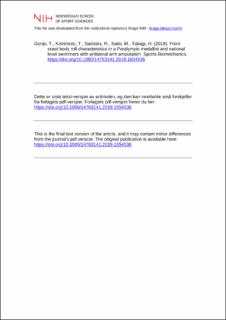| dc.contributor.author | Gonjo, Tomohiro | |
| dc.contributor.author | Kishimoto, Taichi | |
| dc.contributor.author | Sanders, Ross | |
| dc.contributor.author | Saito, Mayumi | |
| dc.contributor.author | Takagi, Hideki | |
| dc.date.accessioned | 2020-09-03T12:47:14Z | |
| dc.date.available | 2020-09-03T12:47:14Z | |
| dc.date.created | 2019-12-16T11:43:43Z | |
| dc.date.issued | 2019 | |
| dc.identifier.citation | Sports Biomechanics. 2019, under utgivelse. | en_US |
| dc.identifier.issn | 1476-3141 | |
| dc.identifier.uri | https://hdl.handle.net/11250/2676270 | |
| dc.description | I Brage finner du siste tekst-versjon av artikkelen, og den kan inneholde ubetydelige forskjeller fra forlagets pdf-versjon. Forlagets pdf-versjon finner du på tandfonline.com/ / In Brage you'll find the final text version of the article, and it may contain insignificant differences from the journal's pdf version. The original publication is available at tandfonline.com/ | en_US |
| dc.description.abstract | The purpose of this study was to establish the asymmetry and body wave characteristics related to shoulder, hip, knee, and ankle roll in unilateral arm amputee swimmers. Three unilateral arm amputee swimmers, including one Paralympic medallist (swimmer A), volunteered in this study. They conducted two 10-15 s front crawl tests with sub-maximum and maximum speeds in a flume. Shoulder, hip, knee, and ankle roll amplitude and progression of a torsional body wave was quantified using a motion capture system and a Fourier analysis. Swimmer A showed 50% higher stroke frequency than the other swimmers. Swimmers achieved larger shoulder roll amplitude towards the affected than the unaffected side by 19–89%. Swimmer A showed body wave velocity slowing down when it travelled caudally, while national level swimmers presented increasing wave velocity, suggesting that swimmer A had a less effective kicking than the other swimmers. In conclusion, the technique of the unilateral arm amputee swimmers was characterised by a large shoulder roll angle towards the affected side. The Paralympic medallist had larger shoulder roll asymmetry and less effective kicking than the other swimmers and yet achieved higher swimming speed because of his high stroke frequency. | en_US |
| dc.language.iso | eng | en_US |
| dc.subject | swimming | en_US |
| dc.subject | kinematics | en_US |
| dc.subject | shoulder roll | en_US |
| dc.subject | rhythm | en_US |
| dc.subject | motor control | en_US |
| dc.title | Front crawl body roll characteristics in a Paralympic medallist and national level swimmers with unilateral arm amputation | en_US |
| dc.type | Peer reviewed | en_US |
| dc.type | Journal article | en_US |
| dc.description.version | acceptedVersion | en_US |
| dc.source.pagenumber | 1-18 | en_US |
| dc.source.journal | Sports Biomechanics | en_US |
| dc.identifier.doi | 10.1080/14763141.2019.1654536 | |
| dc.identifier.cristin | 1761102 | |
| dc.description.localcode | Seksjon for fysisk prestasjonsevne / Department of Physical Performance | en_US |
| cristin.ispublished | true | |
| cristin.fulltext | postprint | |
| cristin.qualitycode | 1 | |
